Kalanchoe is commonly grown as a houseplant, but in climates where frost isn’t a risk, it works best outdoors, where it can spread and root along its stem to form dense clumps of brightly blooming succulent plants.
Wherever you want to grow kalanchoe, we’ve got all the tips to keep it happy throughout the year if you’re growing kalanchoe in Australia. From fertiliser to water requirements, and a great list of our favourite kalanchoe varieties to extend your flowering seasons.
More...
Family: | Crassulaceae |
|---|---|
Genus: | Kalanchoe |
Common Names: | Flaming Katy |
Location: | Indoor or outdoor |
Type: | Flowering succulent |
Growth: | 45cmx50cm |
Sun requirements: | Full sun, part sun |
Foliage Colour: | Green |
Flower Colour: | Orange, Red, Yellow, Pink |
Flowering: | Winter to Spring |
Fruit: | None |
Maintenance level: | Medium |
Poisonous for pets: | Toxic to pets if ingested |
What is a Kalanchoe?
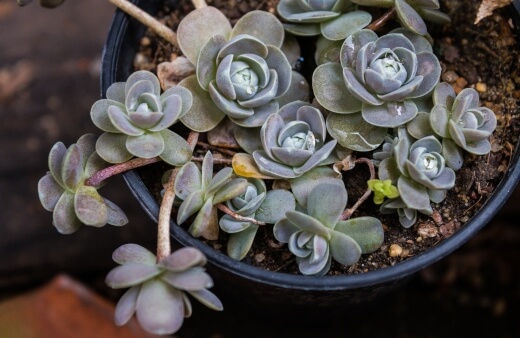
Kalanchoe is a genus comprising over 120 succulent tropical plants. If you’re not already familiar with its name, you will have seen it planted around cities, where it provides excellent perennial bedding in all shades of red, yellow, and orange.
Its foliage, when healthy, is a bright emerald shade of green, with neatly undulating edges to each leaf. Kalanchoes' fibrous roots take well in water or soil, and after a few years in a container, you’ll notice a thinning of the lower stems. This is natural, and part of the plant’s desire to crawl.
As kalanchoe stems mature, they develop roots from old leaf nodes, making excellent cutting material, or, easier still, self-rooting stems which can be laid against the ground for a fresh flush of foliage.
Flaming Katy’s Natural Habitat
Kalanchoe is native to Madagascar and Southern and Eastern Africa, each with 60 and 56 species respectively. A few species groups can be found in China and throughout Southern and Southeast Asia.
Essentially, anywhere where the weather is hot, with reasonably fertile soil and good drainage will suit kalanchoe well. As succulents they are adapted to store water in reserve in each leaf, enabling them to last well through droughts.
10 Best Kalanchoes Varieties to Grow in Australia
1. Kalanchoe blossfeldiana (Flaming Katy)Also known as flaming Katy, or the Panda Plant, K. blossfeldiana is one of the most popular kalanchoes to grow in the world. Its salmon-pink flowers bloom in bright clusters on 40cm tall stems, making them ideal for statement bedding. They thrive outdoors in Australia, and need very good drainage, meaning they can cope well with average rainfall during their flowering season. | 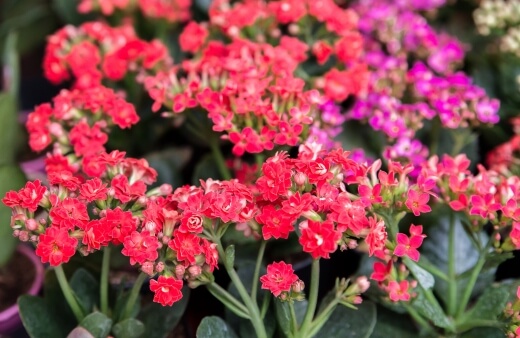 |
2. Kalanchoe thyrsiflora (Paddle Plant)K. thyrsiflora is taller, and wider than most kalanchoes, with sturdy, thick leaves, with a cupped structure. Each leaf had a gorgeously delicate red rim which fades delicately into a pale silvery-green centre. They flower reliably in early spring, and can be encouraged to go on flowering into summer with the right feed, but are predominantly grown for their stunning foliage. |  |
3. Kalanchoe tomentosa (Panda Plant)Another kalanchoe with foliage even more beautiful than its flowers. These silvery succulents have thick leaves, tipped with soft, textured, red details. They flower in spring like most kalanchoes, but look at their best when pruned annually in summer after flowering, and fed with general 10-10-10 garden fertiliser to support healthy foliage, which decorates the garden all year round. | 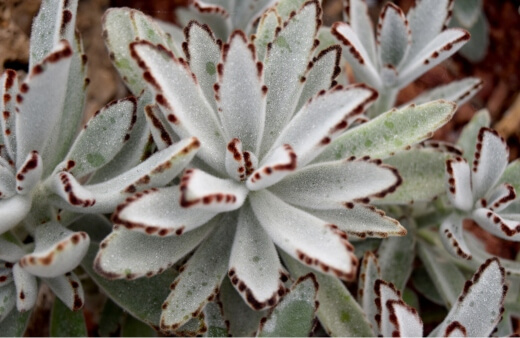 |
4. Kalanchoe daigremontiana (Devil's backbone)You’d be hard pressed to find a more interesting kalanchoe than K. daigremontiana, with its twisted leaves that point out dramatically from each main stem, covered in chunky, globular fringes around the edge of each leaf. The grey-green underside to each leaf adds interest to rockeries and raised beds too, where you benefit from all angles of this stunning plant. | 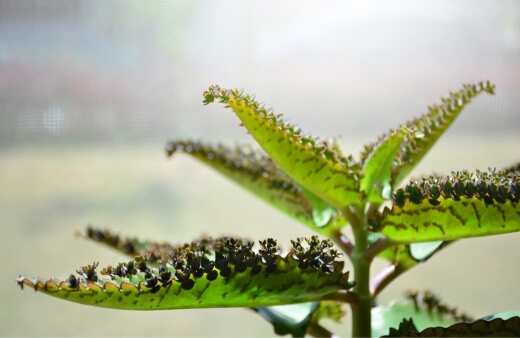 |
5. Kalanchoe fedtschenkoi (Lavender Scallops)The flowers of K. fedtschenkoi are a little different from most. They droop delicately downwards like an organic candelabra from slender purplish stems, which shoot up from delicate pink and green foliage that grows in tall rosettes from the ground. | 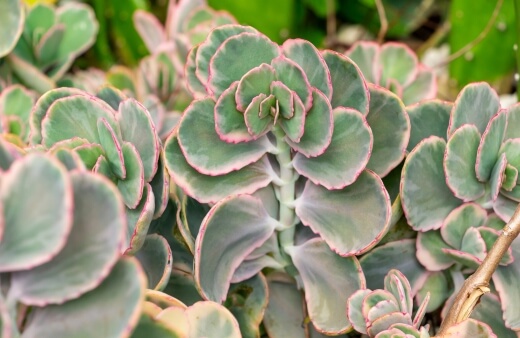 |
6. Kalanchoe pinnata (Cathedral Bells)If you’ve ever wondered why kalanchoe is such an easy plant to propagate, check out K. pinnata, which naturally develops new leaves around the fringe of each and every leaf. The textures and shadows cast from this structurally fascinating plant are unrivalled by any other kalanchoe and work beautifully in gravel gardens. | 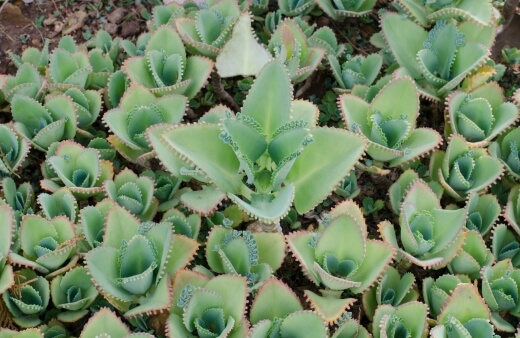 |
7. Kalanchoe beharensis (Elephant’s Ear Kalanchoe)K. beharensis breaks all the rules for kalanchoe, growing well over 12m tall in the right conditions, with dramatic foliage. The leaves are twisted and curled on thick stems, and flower with stunning, but muted russet-toned flowers in spring. The giant leaves of this huge kalanchoe give it its common name; Elephant’s Ear Kalanchoe. | 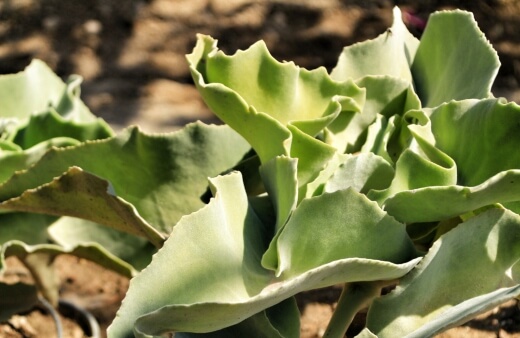 |
8. Kalanchoe delagoensis (Chandelier Plant)This unusual kalanchoe is perfect for pots and containers, particularly in prominent spots in the garden as a talking point, with leaves made up of many smaller leaves, all growing together in a long, spiked form, with bright green undersides, and purple tops. Each small leaf has a white fringe, adding to the beauty of this stunning pot plant, which will come back year after year with regular pruning. |  |
9. Kalanchoe pumila (Flower Dust Plant)K. pumila is slightly harder to grow than most and needs watering more regularly. Its trailing habit makes it quite susceptible to stem and leaf rot when it comes into contact with the floor, so grow it somewhere bright, ideal in a container so it can trail naturally without becoming damp. |  |
10. Kalanchoe luciae (Flapjack Plant)When I first saw K. luciae I didn’t realise it was a kalanchoe at all. Its dense foliage and short stems make it look more like a low-growing alpine. When it flowers, it does so on dramatically tall stems, which burst out from the tight rosette of red tinted leaves, each with their own drama. Grow K. luciae in a compost mix that is nearly 75% grit or perlite to provide excellent drainage. Water when the soil is dry. |  |
1. Kalanchoe blossfeldiana (Flaming Katy)

Also known as flaming Katy, or the Panda Plant, K. blossfeldiana is one of the most popular kalanchoes to grow in the world. Its salmon-pink flowers bloom in bright clusters on 40cm tall stems, making them ideal for statement bedding.
They thrive outdoors in Australia, and need very good drainage, meaning they can cope well with average rainfall during their flowering season.
2. Kalanchoe thyrsiflora (Paddle Plant)

K. thyrsiflora is taller, and wider than most kalanchoes, with sturdy, thick leaves, with a cupped structure. Each leaf had a gorgeously delicate red rim which fades delicately into a pale silvery-green centre.
They flower reliably in early spring, and can be encouraged to go on flowering into summer with the right feed, but are predominantly grown for their stunning foliage.
3. Kalanchoe tomentosa (Panda Plant)

Another kalanchoe with foliage even more beautiful than its flowers. These silvery succulents have thick leaves, tipped with soft, textured, red details.
They flower in spring like most kalanchoes, but look at their best when pruned annually in summer after flowering, and fed with general 10-10-10 garden fertiliser to support healthy foliage, which decorates the garden all year round.
4. Kalanchoe daigremontiana (Devil's backbone)

You’d be hard pressed to find a more interesting kalanchoe than K. daigremontiana, with its twisted leaves that point out dramatically from each main stem, covered in chunky, globular fringes around the edge of each leaf.


Get Your Free Guide:
Master Growing Australian Natives eBook
A Must Have Complete Guide for Every Australian Garden
Get Your Free Guide:
Master Growing Australian Natives eBook
A Must Have Complete Guide for Every Australian Garden
The grey-green underside to each leaf adds interest to rockeries and raised beds too, where you benefit from all angles of this stunning plant.
5. Kalanchoe fedtschenkoi (Lavender Scallops)

The flowers of K. fedtschenkoi are a little different from most. They droop delicately downwards like an organic candelabra from slender purplish stems, which shoot up from delicate pink and green foliage that grows in tall rosettes from the ground.
6. Kalanchoe pinnata (Cathedral Bells)

If you’ve ever wondered why kalanchoe is such an easy plant to propagate, check out K. pinnata, which naturally develops new leaves around the fringe of each and every leaf.
The textures and shadows cast from this structurally fascinating plant are unrivalled by any other kalanchoe and work beautifully in gravel gardens.
7. Kalanchoe beharensis (Elephant’s Ear Kalanchoe)

K. beharensis breaks all the rules for kalanchoe, growing well over 12m tall in the right conditions, with dramatic foliage. The leaves are twisted and curled on thick stems, and flower with stunning, but muted russet-toned flowers in spring.
The giant leaves of this huge kalanchoe give it its common name; Elephant’s Ear Kalanchoe.
8. Kalanchoe delagoensis (Chandelier Plant)

This unusual kalanchoe is perfect for pots and containers, particularly in prominent spots in the garden as a talking point, with leaves made up of many smaller leaves, all growing together in a long, spiked form, with bright green undersides, and purple tops.
Each small leaf has a white fringe, adding to the beauty of this stunning pot plant, which will come back year after year with regular pruning.
9. Kalanchoe pumila (Flower Dust Plant)

K. pumila is slightly harder to grow than most and needs watering more regularly. Its trailing habit makes it quite susceptible to stem and leaf rot when it comes into contact with the floor, so grow it somewhere bright, ideal in a container so it can trail naturally without becoming damp.
10. Kalanchoe luciae (Flapjack Plant)

When I first saw K. luciae I didn’t realise it was a kalanchoe at all. Its dense foliage and short stems make it look more like a low-growing alpine.
When it flowers, it does so on dramatically tall stems, which burst out from the tight rosette of red tinted leaves, each with their own drama.
Grow K. luciae in a compost mix that is nearly 75% grit or perlite to provide excellent drainage. Water when the soil is dry.
How to Grow Kalanchoes in Australia
Kalanchoe are best grown outdoors but can be grown to good effect indoors if you want to brighten up your kitchen table or add interest to a sunny windowsill without having to worry too much about water.
Below, we’ve got guides to growing kalanchoe outdoors and indoors too.
Growing Kalanchoe Outdoors
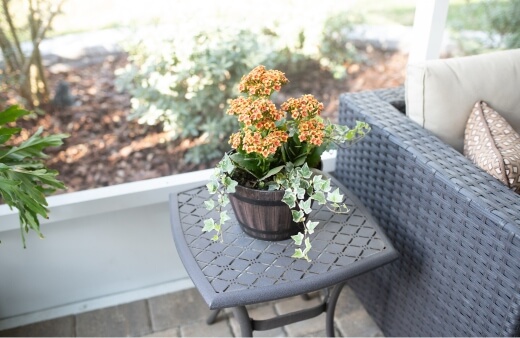
Kalanchoes do best in full or part sun, with around 6-8 hours of direct light per day. If they get a little less, they’ll be fine, but the more light they receive, the fuller their foliage will be.
By adding regular bloom-boosting fertiliser into the mix, you can improve flowering and even extend the season. Follow our guide to the best soil, light, temperature, and water requirements for outdoor kalanchoe below.
What Soil to Use
Kalanchoes need well-drained soil, but with some water retention. Most Australian garden soil will do nicely with a few handfuls of decent compost thrown in to add balanced nutrients.
Avoid planting kalanchoe out in winter or summer. Instead, plant young plants when the weather is milder, either in autumn or spring. This ensures that the soil is at a reasonable temperature and your seedlings won’t go into shock.
Sunlight Needs
Kalanchoes need 6-8 hours of sunlight per day to perform at their best. The more light a kalanchoe gets, the more vigorously it grows, and the denser and healthier its foliage will be.
Conversely, less light and slightly cooler temperatures in summer will help to extend its flowering season. Finding the balance can be tough, but as a general rule, aim for more light, and feed to encourage blooms.
Temperature
Kalanchoe are hot climate plants, native to South Africa and Madagascar. They grow best outdoors in Northern and Western Australia, but can be treated either as annuals, or brought indoors for winter, in south, central or eastern Australia.
Treat the above as guidance, as we’ve had some great experience growing kalanchoe as a perennial succulent even in Tasmania, where they grow well through winter provided they are covered before any frost hits.
Watering Outdoor Kalanchoe
Kalanchoe needs decent drainage. Despite being incredibly easy to take cuttings from in water, they generally prefer to have slightly dryer roots and hold their moisture in their leaves. This means mixing grit into any clay soils and avoiding watering other than during droughts.
Like most succulents, they care for themselves when it comes to watering, so water them in well once, then leave them be.
How to Grow Kalanchoe Indoors
Indoor kalanchoes are easy to grow and even easier to care for. Either grow them from seeds or cuttings (see the guide below), or from young plants. They quickly fill their containers and flower brilliantly in a North facing window.
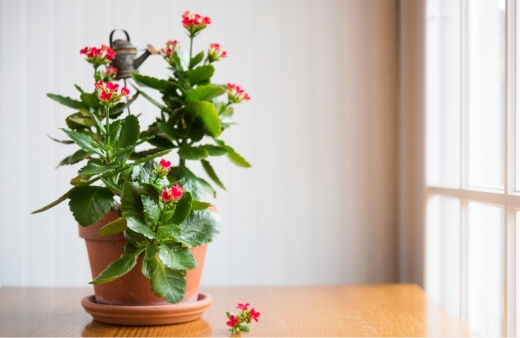
Kalanchoe Pot Size
Kalanchoes don’t mind being restricted and have slow-growing roots, so choose a pot that looks good. If roots are coming out of the base of the pot, pot up 1” larger than the root ball. If not, just find a good-looking pot that fits the existing plant.
Kalanchoe Potting Compost
Kalanchoes need really good drainage indoors, so choose a cacti and succulent compost that’s packed with perlite or grit. This helps the roots to develop freely in well-aerated soil, with a slightly nutrient boost.
If you prefer to mix your own compost, take 1/3 garden compost, and mix with 1/3 loamy soil and 1/3 perlite or grit. This is a useful mix for kalanchoe, particularly on bright windowsills and water can drain freely, but it won’t dry out completely.
Watering Indoor Kalanchoe
Succulents are super easy to care for. If the leaves on your kalanchoe are looking a little anaemic or drooping slightly it's time for water. After a few weeks, you’ll get to know the rhythms of the plant, which can change dramatically depending on its location.
The brighter it is, the more regularly you should water (once a fortnight is usually enough), but in darker spots, like the kitchen table, slightly set away from the window, kalanchoe can often last for up to a month without water.
Guide to Propagating Kalanchoe
Kalanchoe is one of the easiest tropical plants to propagate, from seed or cuttings. If you give it light, a little water, and time, you can get dozens of plants completely free, making kalanchoe one of the most cost-effective bedding plants you can grow in Australia.
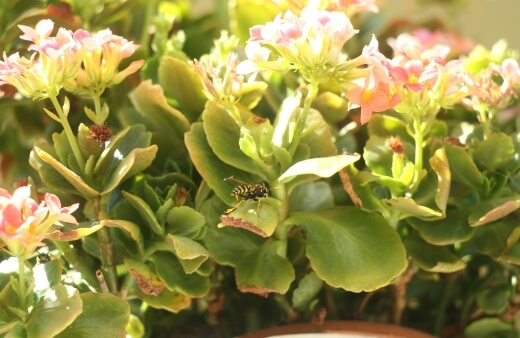
Kalanchoe Propagation from Seeds
If you live in cooler parts of the country, there’s always a chance that a cold winter could kill off your kalanchoes, so growing them from seed each year is a great way to boost your stock, and ensure a floriferous garden through spring and early summer.
To grow kalanchoe from seed, all you need is a few small pots, filled just below the brim with seed compost, or a succulent and cactus potting mix.
Then sow two seeds in the centre of each pot, and water it in well. Leave it somewhere bright and warm for a few weeks until you see signs of germination (Kalanchoe can germinate at any time of year, but is best sown in late winter for a display in the same year).
After germination, simply prick out the weakest seedling, leaving one plant per pot. Keep the soil moist but not wet until it’s ready to plant out.
How to Propagate Kalanchoe from Cuttings
Kalanchoe cuttings take almost too easily. Because each stem is covered in leaf nodes, as each leaf falls, the node will form roots wherever it detects humidity. This can leave kalanchoes looking leggy, with much more on top, and a bare bottom.
To renew leggy kalanchoes, cut them right down, and place the bare stems (with a few leaves at the top) in a glass of water. After two or three weeks there should be masses of roots, ready to plant into a good free draining compost mix.
You can take kalanchoe cuttings by popping them straight into moist compost too, but the water method is more reliable.
Propagating Kalanchoes from leaf cuttings
Kalanchoes have incredibly active rooting hormones already built into their stems and leaves. If any leaves fall from the plant, try propagating them. Allow them to callous over for 2-3 days, then place them on the surface of moist compost.
Keep the compost moist by misting it once every couple of days, and in a few weeks, you’ll see tiny kalanchoe plants sprouting from the base of each leaf.
Caring for Kalanchoe
Kalanchoes need very little ongoing care, but only really look good for their first two or three years. After that, you’ll need to prune them, repot them, and take cuttings to replace the old plants.
In loose garden soil, kalanchoes can actually replace themselves as the stems droop and root into the soil, creating new plants naturally. If you prefer to take more control though, follow our cutting guide above for kalanchoe propagation tips.
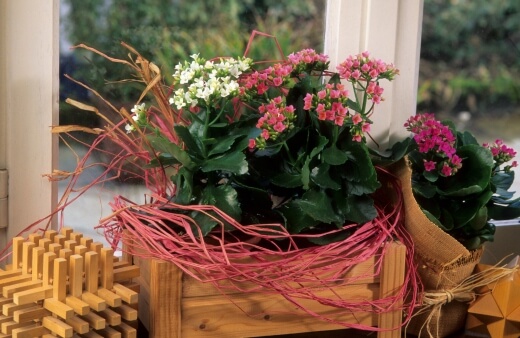
Fertiliser for Kalanchoe
Kalanchoe are incredibly responsive to fertiliser. General garden fertilisers can be high in nitrogen, which leads to healthy, bushy foliage, often at the expense of flowers.
Feed kalanchoes with a general liquid fertiliser through autumn and summer, to promote healthy, bushy growth. As winter sets in, feed with low nitrogen feed or bloom booster fertiliser, which then tells the plant to focus on flowering.
In some parts of the country, kalanchoes will flower all year round, but you’ll get much better displays if you focus on foliage in the warmer months, and a less balanced NPK in the cooler months.
Pruning and Repotting
After two years (three if you’re lucky), you’ll need to replace or repot kalanchoes. Thankfully this is pretty simple.
To repot container planted kalanchoes, simply tip them from their existing pot, and bury them down to their foliage in a new container filled with free draining compost.
Kalanchoes will root again from each stem, so your one original plant can become several in one easy step. As young kalanchoes develop it’s worth pinching out each stem to encourage more lateral growth and a bushier plant.
The more stems you have, the more flowers you’ll get!
Kalanchoe Pests and Diseases
While kalanchoe is fairly resistant to pests in the garden it can suffer incredibly badly indoors. For outdoor kalanchoes, the biggest risks are fungal and bacterial diseases, but thankfully they are resilient plants.
Below, we’ve put together a simple list of the most common problems faced by kalanchoe plants, and how to treat them.
There are only three truly problematic pests that commonly affect kalanchoe in Australia; mealybug, aphids, and scale. For all three, the treatment is roughly the same, but the signs differ greatly.
Mealybugs
Mealybugs are tiny cream-coloured insects that look like tailed woodlice under the microscope. They cover themselves in a bitter secretion to put off predators, so can only really be dealt with through pesticides.
However, the best practical course of attack for mealybugs is rubbing alcohol, which dries them out and dehydrates them completely. Simply rub a cotton swab in alcohol and wipe it over infestations. This does two things; kills adults, and disrupts the breeding cycle.
Aphids
Aphids can be treated in a similar way to mealybug, with alcohol wipes, but are also easily killed by organic pesticides like neem oil.
If you notice dense clusters of white, black, or green insects around fresh growing tips, they are most likely aphids. They can be scraped off, but neem oil helps to prevent further infestation.
Refer to our guide to learn more about aphids, their types, and how to get rid of them naturally.
Scale Insects
Scale insects are frustrating and almost always carry diseases with them, which can impact plant health. Horticultural soap will help to kill the scale, while also drying out potential fungal spores that could harm your plant too.
Wherever you grow kalanchoe, the biggest risk to its health is over watering. Succulents are incredibly good at recovering from drought, so if in doubt, let it dry out!

The majority of diseases which affect kalanchoes are fungal, caused, and exacerbated by overwatering, or damp soil conditions. Some bacterial problems will enter damaged stems or leaves, but these are worsened by humidity too.
Root Rot
There are several different types of fungal root rot that can affect kalanchoe (Lasiodiplodia, Cylindrocladium, Phytophthora, Pythium, Rhizoctonia). All can be avoided by not overwatering, but if they do occur, the best treatment is to take cuttings and start again.
Root rot is incredibly difficult to cure, but if you take cuttings as a precaution, then dig up your plants and remove any damaged roots, there is a chance you can save the original plant too.
Simply cut away any black, brown, squishy, or smelly roots, leaving just healthy roots. Then, rinse them off completely with clean water. Finally, replant kalanchoes in clean compost.
Stem Rot (Fusarium, Botryosphaeria, Lasiodiplodia)
Kalanchoe stem rot is a big problem and is often caused by insect damage (typically aphids). Damaged stems allow fungal spores to spread inside the plant, causing black lesions which can spread to foliage.
Cut every leaf above the infection away, and treat the plant with an organic fungicide.
Leaf Spot
There are three fungal pathogens that cause leaf spot on kalanchoes (Cercospora, Cladosporium, Stemphylium). Keeping a low humidity around kalanchoes should be fairly simple, provided you’ve planted them as bedding, in containers, or away from dense shrubbery.
Try not to water the leaves, and target water at the base of the plant to avoid spreading and fostering fungal leaf spots. Remove any spotted foliage to prevent spread.
Powdery Mildew
Powdery mildew is hard to spot on kalanchoe but is more common in mixed-use gardens. Annual plants and veggies are commonly affected by mildew, and the infection is the same. However, on kalanchoe it looks stringier and less even.
The best treatment for powdery mildew on kalanchoe is to treat the entire plant with a spray fungicide in mid-morning, which allows the plant to dry out in the afternoon.
Blight (Southern & Botrytis)
Blight is a fungal problem that can affect any plant with poor ventilation. It is much more common on indoor kalanchoe, but can be spread from other plants in the garden.
If you find blight (blackened stems that spore when touched, or brown spots on leaves, with yellow rings around them) remove as much plant material as you can to prevent spread, then burn it.
Kalanchoe Mosaic
Kalanchoe mosaic virus looks like it sounds. Foliage will develop patchy markings in yellows, browns, and pale greens, which can quickly spread to other leaves and plants.
It can be treated with fungicides, but the only fully organic method is to remove the plant and replace it.
Kalanchoe Frequently Asked Questions

Do kalanchoe come back every year?
Kalanchoe comes back every year in most of Australia, making it an ideal bedding plant for warmer climates. However, they are relatively short-lived plants in terms of reliable structure, as they tend to fade, and become leggy after a couple of years.
Is kalanchoe an indoor or outdoor plant?
Kalanchoe can be grown indoors and outdoors and is hardy in USDA zones 10 to 12 (most of Australia). While they have a longer flowering period outdoors, kalanchoe can still be stunning plants for sunny winter windowsills.
How long will a kalanchoe live?
Kalanchoe plants can live up to seven yards with proper care but generally look their best for around three years. If you regularly prune back old stems and repot your kalanchoes into deeper soil, that will help to extend their lifespan.
How to prune a kalanchoe after flowering?
After flowering, kalanchoes can have very leggy stems, and lose a lot of their leaves. To encourage re-flowering, and healthier plants next year, cut each flowering stem right back to about 1” above the ground when the flowers fade. This encourages new, bushier growth.
Interested in growing more succulents? Check out our guide to growing Zygocactus in Australia.
Add Tropical Beauty by Growing Kalanchoes in Your Garden
No matter where you live, kalanchoes can be grown to great effect outdoors, and are one of the best ornamental bedding plants you can grow, especially if you want to bring a little bit of tropical beauty into the garden.
Can't get enough of succulents? See our list of the best types of succulents to grow in Australia.
Try growing kalanchoe indoors too, for an easy bit of winter sunshine in the house for those colder months when less is in bloom. The beautiful, bright blooms of kalanchoe are simple to achieve even for novice gardeners.
Published on September 28, 2022 by Maisie Blevins
Last Updated on February 22, 2025





Hi, Im trying to find Kalanchoe daigremontiana . Is that normally best to have as an indoor plant? Im in Victoria ,Thanks
Hi Antonia,
It’s not hardy, so it would need some protection in winter. We’ve had it outdoors down to about -5°C but it needed to be cut back, and then started up again in spring. We bring it indoors now over winter just in case.
They’re definitely happiest outdoors though if you can give them a good-sized pot with plenty of drainage and a regular feed. They like being outside through summer anywhere in the world, but just with a bit of caution when it comes to winter time.
Best regards,
Gary Clarke